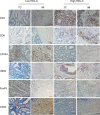Correlation between immune signature and high-density lipoprotein cholesterol level in stage II/III colorectal cancer
- PMID: 30729718
- PMCID: PMC6434197
- DOI: 10.1002/cam4.1987
Correlation between immune signature and high-density lipoprotein cholesterol level in stage II/III colorectal cancer
Abstract
An increasing amount of evidence suggests that high-density lipoprotein cholesterol (HDL-C) is related to a positive prognosis in various cancers. However, the correlation between HDL-C and the immune signature and the prognostic role of HDL-C in stage II/III colorectal cancer (CRC) has not been previously reported. A total of 667 CRC patients were enrolled and divided into two groups based on the lower limit of normal HDL-C values (0.78 mmol/L). We used Kaplan-Meier curves and the Cox regression model to analyze the prognostic role of HDL in both disease-free survival (DFS) and overall survival (OS). Fifty-five pairs of tumor tissues were selected according to the variation in HDL-C levels (high or low) and the matched characterizes (ages, T stage, and N stage). Using immunohistochemistry, tumor tissues were stained with antibodies against CD3, CD8, CD163, iNOS, Forkhead box P3 (FOXP3), and CD33. We calculated the density of positively-stained infiltrating cells in the tumor center (TC) and invasive margin (IM). We then used Spearman rank correlation to further investigate the relationship between HDL-C levels and the immune signatures. Our results revealed that compared to patients with high HDL-C levels, patients with low HDL-C levels had poor 3-year DFS (68.9% vs 83.1%, P = 0.032) and 5-year OS rates (66.6% vs 85.3%, P = 0.002). We also identified a positive correlation between HDL-C and CD3+ , CD8+ and iNOS+ cells and a negative correlation between HDL-C and CD163+ cells in both the TC and IM. This study reveals that a low HDL-C level in stage II/III CRC patients predicts poor prognosis. The correlation between the HDL-C level and immune signature in tissue specimens suggested that HDL-C is likely to play an inhibitory role in tumor development via affecting immune responses.
Keywords: HDL-C; colorectal cancer; immune signature.
© 2019 The Authors. Cancer Medicine published by John Wiley & Sons Ltd.
Conflict of interest statement
None declared.
Figures



References
-
- Chen W, Zheng R, Baade PD, et al. Cancer statistics in China, 2015. CA Cancer J Clin. 2016;66:115‐132. - PubMed
-
- Dai Z, Zheng RS, Zou XN, et al. Analysis and prediction of colorectal cancer incidence trend in China. Zhonghua Yu Fang Yi Xue Za Zhi. 2012;46:598‐603. - PubMed
-
- Iinuma H, Watanabe T, Mimori K, et al. Clinical significance of circulating tumor cells, including cancer stem‐like cells, in peripheral blood for recurrence and prognosis in patients with Dukes' stage B and C colorectal cancer. J Clin Oncol. 2011;29:1547‐1555. - PubMed
-
- Winawer S, Fletcher R, Rex D, et al. Colorectal cancer screening and surveillance: clinical guidelines and rationale‐update based on new evidence. Gastroenterology. 2003;124:544‐560. - PubMed
-
- Jafri H, Alsheikh‐Ali AA, Karas RH. Baseline and on‐treatment high‐density lipoprotein cholesterol and the risk of cancer in randomized controlled trials of lipid‐altering therapy. J Am Coll Cardiol. 2010;55:2846‐2854. - PubMed
Publication types
MeSH terms
Substances
LinkOut - more resources
Full Text Sources
Medical
Research Materials

